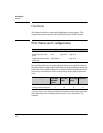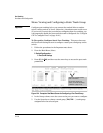
Port Trunking
Port Status and Configuration
Table 12-3. General Operating Rules for Port Trunks
Media: All ports on both ends of a trunk group must have the same media type and mode (speed and duplex). The switch
blocks any trunked links that do not conform to this rule. (For the switches covered in this guide, HP recommends leaving
the port Mode setting at Auto or, in networks using Cat 3 cabling, Auto-10.)
Port Configuration: The default port configuration is Auto, which enables a port to sense speed and negotiate duplex
with an Auto-enabled port on another device. HP recommends that you use the Auto setting for all ports you plan to use
for trunking. Otherwise, you must manually ensure that the mode setting for each port in a trunk is compatible with the
other ports in the trunk.
Recommended Port Mode Setting for LACP
All of the following operate on a per-port basis, regardless of trunk membership:
• Enable/Disable
• Flow control (Flow Ctrl)
LACP is a full-duplex protocol. See
“Trunk Group Operation Using LACP” on page 12-18.
Trunk Configuration: All ports in the same trunk group must be the same trunk type (LACP, Trunk, or FEC). All LACP ports
in the same trunk group must be either all static LACP or all dynamic LACP.
A trunk appears as a single port labeled
Dyn1 (for an LACP dynamic trunk) or Trk1 (for a static trunk of any type:
LACP, Trunk, or FEC) on various menu and CLI screens. For a listing of which screens show which trunk types, see “How
the Switch Lists Trunk Data” on
page 12-26.
For STP or VLAN operation, configuration for all ports in a trunk is done at the trunk level. (You cannot separately configure
individual ports within a trunk for STP or VLAN operation.)
Traffic Distribution: All of the switch trunk protocols use the SA/DA (Source Address/Destination Address) method of
distributing traffic across the trunked links. See
“Outbound Traffic Distribution Across Trunked Links” on page 12-26.
Trunk Group Boundary Requirement for the Series 2800 Switches When IP Routing is Enabled: On the Switch 2824 and
Switch 2848, manually or dynamically configuring a trunk with ports belonging to different port groups is not supported
if IP routing is enabled. Each trunk group must be comprised only of ports from the same port group, as shown below:
• Ports 1- 12 (Switch 2824 and 2848.)
• Ports 13 - 24 (Switch 2824 and 2848.)
• Ports 25 - 36 (Switch 2848 only.)
• Ports 37 - 48 (Switch 2848 only.)
For example, you can configure a new trunk (or the switch can dynamically configure an LACP trunk) comprised of ports
1, 3, 4, 7, 8, 10, 11, and 12, and another trunk comprised of ports 13, 14, 17, 18, 20, 21, 22, and 24. However, for example,
configuring a trunk, or allowing a dynamic LACP trunk to occur with some ports in the range of 1 - 12 and other ports in
the range of 13 - 24 is not supported if IP routing is enabled. When IP routing is disabled, any eligibleswitch ports (having
the same media type and mode (speed and duplex)) can be used in a trunk group,
12-8


















